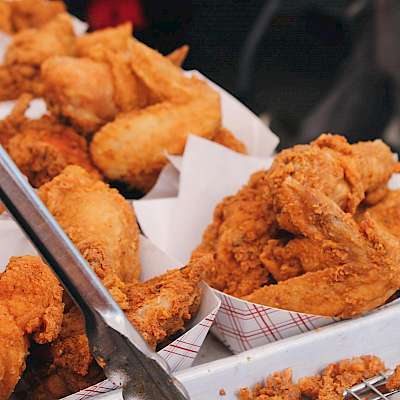Chicken consumption is growing in the UK, red meat sales were overtaken by poultry for the first time in 2017. Analysts have said that this is partly down to classic ‘meat and two veg’ meals falling out of fashion, and the ease in which the likes of chicken and turkey can be used in creating simple meals for one. This substitution may also have been influenced by the fact that red meat has been the focus of health and environment campaigns for a long time.
Poultry has become a cheap source of animal protein but the growth in consumption raises some concerns. Substituting red meat for chicken isn’t an effective way to reduce the environmental impact of meat. Red meat has been the focus of recent environmental campaigns for its contribution to greenhouse gases. But poultry also has a relatively high carbon footprint, and moreover contributes to land use change and greenhouse gas emissions as it is predominantly fed on imported soya from South America. Globally 1kg of chicken meat requires 3.2 kg of human-edible feed, this is not just a waste it is also higher than for the same amount of red meat.
95% of chickens reared for meat in the UK are kept indoors - in large scale, automated factory units which can hold hundreds of thousands of birds. [Provided by British Poultry Council, taken from retail sales data]. The intense crowding of chickens in factory farming increases the likelihood of sickness and infection, thereby precipitating the use of preventive antibiotics. Overuse of antibiotics in farm animals is a key driver of antibiotic resistance, however in the UK poultry industry the use of medically-important antibiotics has been cut in recent years, but there is more to do. Earlier this year the European parliament voted by over 97% for new legislation which will ban preventive antibiotic treatments of groups of healthy animals by 2022. The UK government is yet to pass equivalent legislation. In 2016 researchers found superbugs on the shelves of all seven major UK supermarkets. Cambridge University Professor Mark Holmes said ‘the levels of resistant E. coli that we have found are worrying. Every time someone falls ill, instead of just getting a food poisoning bug, they might also be getting a bug that is antibiotic resistant’.
It isn’t just the amount of chicken we are eating in the UK and the way that it is reared that needs examining. Our impending EU exit leaves some questions yet to be answered. At present, UK consumption and production of chicken is about 60% self-sufficient. UK consumers prefer to eat white breast meat, rather than dark cuts like wings, legs and thighs. At present about 70% of our dark meat exports are to the EU, and the majority of the poultry meat that is imported into the UK, including fresh chicken breast, comes from the EU. This means that the UK is a net importer of poultry – predominantly of chicken breast - whilst producers have to export surplus dark meat to maximise revenue.
Food Research Collaboration is supporting Eating Better to build understanding of the issues of the chicken supply chain. The following questions were posed to examine in the New Year:
- Are there reliable ways of measuring the impacts of broiler feed chains?
- Do slaughterhouses use the most efficient killing methods?
- Does the nutritional profile of a factory-reared chicken differ from that of a high-welfare bird?
- Are certification schemes a realistic way to drive sustainability improvements in the sector?
- Is chicken v beef the right choice – should it be low-welfare chicken v high welfare beef?
- How might post-Brexit trade deals affect UK supply and consumption?
If you would like to contribute to or be kept informed about this project, contact [email protected].
